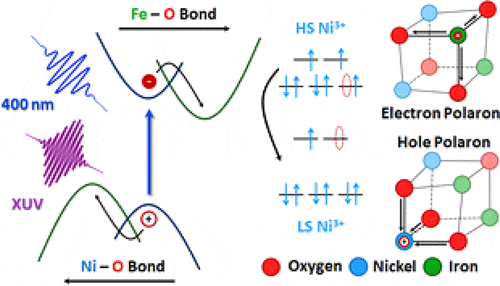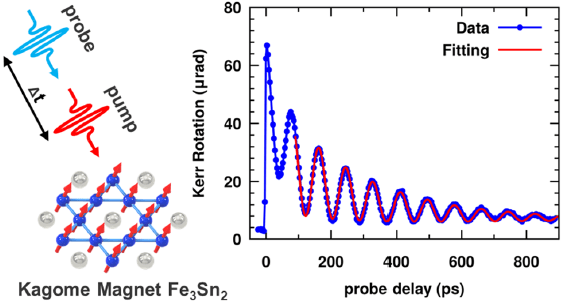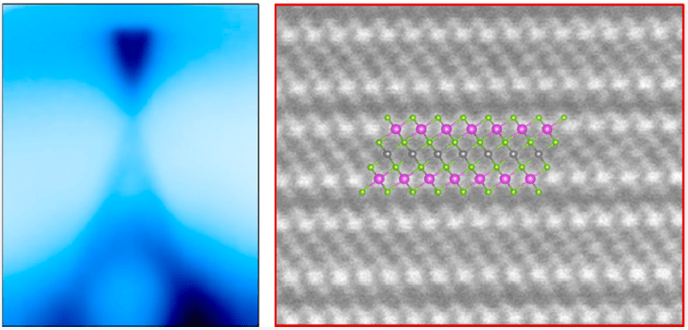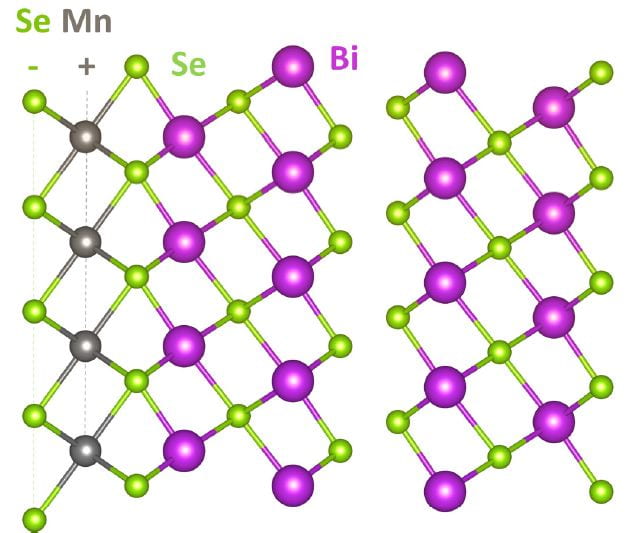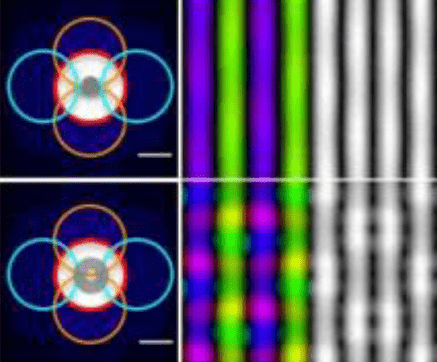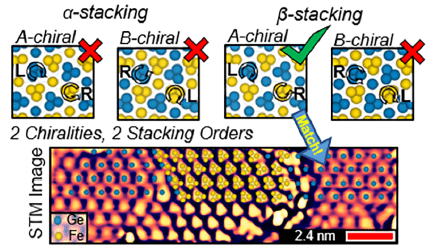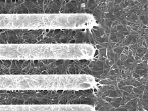2024
Ultrafast dynamics in 2D materials and heterostructures visualized with time- and angle-resolved photoemissionThomas K. Allison, Zachary H. Withers, Ziling Li, Jin Bakalis, Sergii Chernov, Shuyu Cheng, Gerd Schönhense, Xu Du, Roland Kawakami, Alice Kunin, Proceedings Volume 12884, Ultrafast Phenomena and Nanophotonics XXVIII; 128840A (2024) Read MoreThe optical and electronic properties of two-dimensional (2D) materials make them attractive for a variety of applications in quantum information processing, solar-energy harvesting, and catalysis. However, the dynamics of electrons, holes, and excitons formed after photo-excitation are often complex and involve many states that are optically dark, making their characterization with optical spectroscopy alone difficult. We present our recent work imaging the quantum states of 2D materials and their heterostructures in momentum space using time- and angle-resolved photoemission. A unique combination of tunable ultrashort extreme ultraviolet (XUV) pulses with 61 MHz repetition rate and time-of-flight momentum microscopy (ToF k-mic) enables the parallel recording of electron dynamics in all states across the full Brillouin zone after perturbative excitation. We will present results on pseudospin dynamics in graphene, valley circular dichroism in monolayer WS2, and hybridized excitons in MoSe2/WS2 bilayers. |
Quantum octets in high mobility pentagonal two-dimensional PdSe2Yuxin Zhang, Haidong Tian, Huaixuan Li, Chiho Yoon, Ryan A. Nelson, Ziling Li, Kenji Watanabe, Takashi Taniguchi, Dmitry Smirnov, Roland K. Kawakami, Joshua E. Goldberger, Fan Zhang & Chun Ning Lau, Nature Communications volume 15, Article number: 761 (2024) Read MoreTwo-dimensional (2D) materials have drawn immense interests in scientific and technological communities, owing to their extraordinary properties and their tunability by gating, proximity, strain and external fields. For electronic applications, an ideal 2D material would have high mobility, air stability, sizable band gap, and be compatible with large scale synthesis. Here we demonstrate air stable field effect transistors using atomically thin few-layer PdSe2 sheets that are sandwiched between hexagonal BN (hBN), with large saturation current > 350 μA/μm, and high field effect mobilities of ~ 700 and 10,000 cm2/Vs at 300 K and 2 K, respectively. At low temperatures, magnetotransport studies reveal unique octets in quantum oscillations that persist at all densities, arising from 2-fold spin and 4-fold valley degeneracies, which can be broken by in-plane and out-of-plane magnetic fields toward quantum Hall spin and orbital ferromagnetism. |
2023
Room-Temperature Magnetic Skyrmions in Pt/Co/Cu Multilayers |
Tuning the Curie temperature of a two-dimensional magnet/topological insulator heterostructure to above room temperature by epitaxial growth
Read MoreThe heterostructures of 2D magnets and topological insulators are attractive candidates for quantum anomalous hall effect and highly-efficent spin-orbit torque switching. To better study these phenomena, it will be crucial to synthesize epitaxial heterostructures for scalability while maintaining high-quality interfaces to preserve the topological surface states and having the Curie temperature (TC) above room temperature. We utilize molecular beam epitaxy (MBE) to tune the TC in heterostructures of van der Waals (vdW) magnet Fe3GeTe2 and topological insulator Bi2Te3 to above room temperature by varying growth conditions. Cross-sectional scanning transmission electron microscopy (STEM) imaging reveals existence of thicker vdW compouds in the FemGenTe2 family, as well as some intercalants in between vdW gaps, which are possible origins for the enhanced TC.
|
Magneto-Optical Detection of the Orbital Hall Effect in Chromium
Read MoreThe Hall effect was discovered by a PhD student Edwin Hall and his advisor Henry Rowland in 1879. Since then, the family of Hall effects has grown considerably. The anomalous Hall effect, integer and fractional quantum Hall effects, spin Hall effect, quantum anomalous Hall effect are fundamental physics phenomena of great importance, some of them were recognized by Nobel prizes (1985, 1988, 2016). A new member of the Hall effect family has been theoretically predicted recently [1][2][3][4]. It was coined the orbital Hall effect (OHE), as it relies on the orbital motion of electrons instead of their charge as in the original Hall effect. However, its direct observation is a challenge as it is difficult to separate spin and orbital Hall effects in solids. In our recent study, using magneto-optical Kerr effect with nanoradian sensitivity we detected the current-induced orbital accumulation at the surface of a light 3d transition metal, Cr. We found that the orbital polarization is in-plane, transverse to the current direction, and scales linearly with current density, fully consistent with the orbital Hall effect.
|
Epitaxial Kagome Thin Films as a Platform for Topological Flat Bands
Read MoreSystems with flat bands are ideal for studying strongly correlated electronic states and related phenomena. Among them, kagome-structured metals such as CoSn have been recognized as promising candidates due to the proximity between the flat bands and the Fermi level. A key next step will be to realize epitaxial kagome thin films with flat bands to enable tuning of the flat bands across the Fermi level via electrostatic gating or strain. Here, we report the band structures of epitaxial CoSn thin films grown directly on the insulating substrates. Flat bands are observed by using synchrotron-based angle-resolved photoemission spectroscopy (ARPES). The band structure is consistent with density functional theory (DFT) calculations, and the transport properties are quantitatively explained by the band structure and semiclassical transport theory. Our work paves the way to realize flat band-induced phenomena through fine-tuning of flat bands in kagome materials.
|
An Atomically Tailored Chiral Magnet with Small Skyrmions at Room Temperature
Read MoreCreating materials that do not exist in nature can lead to breakthroughs in science and technology. Magnetic skyrmions are topological excitations that have attracted great attention recently for their potential applications in low power, ultrahigh density memory. A major challenge has been to find materials that meet the dual requirement of small skyrmions stable at room temperature. Here we meet both these goals by developing epitaxial FeGe films with excess Fe using atomic layer molecular beam epitaxy (MBE) far from thermal equilibrium. Our atomic layer design permits the incorporation of 20% excess Fe while maintaining a non-centrosymmetric crystal structure supported by theoretical calculations and necessary for stabilizing skyrmions. We show that the Curie temperature is well above room temperature, and that the skyrmions have sizes down to 15 nm as imaged by Lorentz transmission electron microscopy (LTEM) and magnetic force microscopy (MFM). The presence of skyrmions coincides with a topological Hall effect-like resistivity. These atomically tailored materials hold promise for future ultrahigh density magnetic memory applications. |
Momentum-Resolved Exciton Coupling and Valley Polarization Dynamics in Monolayer WS2 |
2022
2021
|
|
|
|
|
2020
|
|
|
|
|
|
|
|
|
2019

Spintronics in 2D MaterialsWei Han and Roland Kawakami, in Spintronics Handbook, Second Edition: Spin Transport and Magnetism : Volume Three: Nanoscale Spintronics and Applications (Editors: E. Y. Tsymbal, I. Žutić, CRC Press, 2019). |

Spectroscopic evaluation of charge-transfer doping and strain in graphene/MoS2 heterostructuresRahul Rao, Ahmad E. Islam, Simranjeet Singh, Rajiv Berry, Roland K. Kawakami, Benji Maruyama, and Jyoti Katoch, Physical Review B 99, 195401 (2019). |

Epitaxial growth of cobalt doped TiO2 thin films on LaAlO3 (100) substrate by molecular beam epitaxy and their opto-magnetic based applicationsSwaleha Naseem, Igor V. Pinchuk, Yunqiu Kelly Luo, Roland K. Kawakami, Shakeel Khan, Shahid Husain, Wasi Khan, Applied Surface Science 493, 691-702 (2019). |
2018

Spin Absorption by In Situ Deposited Nanoscale Magnets on Graphene Spin ValvesWalid Amamou, Gordon Stecklein, Steven J. Koester, Paul A. Crowell, and Roland K. Kawakami, Phys. Rev. Applied 10, 044050 (2018) pdf |

Tuning Spin Dynamics and Localization near the Metal-Insulator Transition in Fe/GaAs HeterostructuresYu-Sheng Ou, N. J. Harmon, Patrick Odenthal, Roland K. Kawakami, Michael E. Flatté, Ezekiel Johnson-Halperin, Physical Review B 98, 134444 (2018). pdf |

Microscopy of Hydrogen and Hydrogen-Vacancy Defect Structures on Graphene DevicesDillon Wong, Yang Wang, Wuwei Jin, Hsin-Zon Tsai, Aaron Bostwick, Eli Rotenberg, Roland K. Kawakami, Alex Zettl, Arash A. Mostofi, Johannes Lischner and Michael F. Crommie, Physical Review B 98, 155436 (2018). pdf |

Transport Spectroscopy of Sublattice-Resolved Resonant Scattering in Hydrogen-Doped Bilayer GrapheneJyoti Katoch, Tiancong Zhu, Denis Kochan, Simranjeet Singh, Jaroslav Fabian and Roland K. Kawakami, Physical Review Letters 121, 136801 (2018). pdf |

Strong and Tunable Spin Lifetime Anisotropy in Dual-Gated Bilayer GrapheneJinsong Xu, Tiancong Zhu, Yunqiu Kelly Luo, Yuan-Ming Lu and Roland K. Kawakami, Physical Review Letters 121, 127703 (2018). Editors’ Suggestion. Highlighted in Physics |

Importance of Paramagnetic Background Subtraction for Determining the Magnetic Moment in Epitaxially Grown Ultrathin van der Waals MagnetsDante O’Hara, Tiancong Zhu and Roland K. Kawakami, IEEE Magnetics Letters 9, 1405805 (2018). pdf |

Spin Inversion in Graphene Spin Valves by Gate-Tunable Magnetic Proximity Effect at One-Dimensional ContactsJinsong Xu, Simranjeet Singh, Jyoti Katoch, Guanzhong Wu, Tiancong Zhu, Igor Žutić and Roland K. Kawakami, Nature Communications 9, 2869 (2018). pdf |

Topological Dirac Semimetal Na3Bi Films in the Ultrathin Limit via Alternating Layer Molecular Beam EpitaxyIgor V. Pinchuk, Thaddeus J. Asel, Andrew Franson, Tiancong Zhu, Yuan-Ming Lu, Leonard J. Brillson, Ezekiel Johnston-Halperin, Jay A. Gupta, Roland K. Kawakami, APL Materials 6, 086103 (2018) pdf |

Probing Tunneling Spin Injection into Graphene via Bias DependenceTiancong Zhu, Simranjeet Singh, Jyoti Katoch, Hua Wen, Kirill Belashchenko, Igor Žutić, Roland K. Kawakami Physical Review B 98, 054412 (2018) pdf |

Electronic Structure of Exfoliated and Epitaxial Hexagonal Boron NitrideRoland J. Koch, Jyoti Katoch, Simon Moser, Daniel Schwarz, Roland K. Kawakami, Aaron Bostwick, Eli Rotenberg, Chris Jozwiak and Søren Ulstrup Physical Review Materials 2, 074006 (2018) pdf |

Modeling the Oblique Spin Precession in Lateral Spin Valves for Accurate Determination of Spin Lifetime Anisotropy: Effect of Finite Contact Resistance and Channel LengthTiancong Zhu and Roland K. Kawakami, Physical Review B 97, 144413 (2018) pdf |

Chiral Bobbers and Skyrmions in Epitaxial FeGe/Si(111) FilmsAdam S. Ahmed, James Rowland, Bryan D. Esser, Sarah Dunsiger, David W. McComb, Mohit Randeria, and Roland K. Kawakami, Physical Review Materials (Rapid) 2, 041401(R) (2018) pdf |

Room Temperature Intrinsic Ferromagnetism in Epitaxial Manganese Selenide Films in the Monolayer LimitDante J. O’Hara, Tiancong Zhu, Amanda H. Trout, Adam S. Ahmed, Yunqiu (Kelly) Luo, Choong Hee Lee, Mark R. Brenner, Siddharth Rajan, Jay A. Gupta, David W. McComb, and Roland K. Kawakami Nano Letters 18, 3125 (2018) pdf |

Magnetic Proximity Effect in Pt/CoFe2O4 BilayersWalid Amamou, Igor V. Pinchuk, Amanda Hanks, Robert Williams, Nikolas Antolin, Adam Goad, Dante J. O’Hara, Adam S. Ahmed, Wolfgang Windl, David W. McComb, and Roland K. Kawakami, Physics Review Materials 2, 011401 (R) (2018). pdf Editors’ Suggestion |

Giant Spin-Splitting and Gap Renormalization Driven by Trions in Single-Layer WS2/h-BN HeterostructuresJyoti Katoch, Søren Ulstrup, Roland J. Koch, Simon Moser, Kathleen M. McCreary, Simranjeet Singh, Jinsong Xu, Berend T. Jonker, Roland K. Kawakami, Aaron Bostwick, Eli Rotenberg, and Chris Jozwiak, Nature Physics 14, 355-359 (2018).pdf |
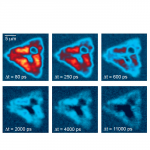
Imaging Spin Dynamics in Monolayer WS2 by Time-Resolved Kerr Rotation MicroscopyElizabeth J. McCormick, Michael J. Newburger, Yunqiu (Kelly) Luo, Kathleen M. McCreary, Simranjeet Singh, Iwan B Martin, Edward J Cichewicz Jr, Berend T. Jonker, Roland K. Kawakami, 2D Materials 5, 011010 (2018). pdf |
2017
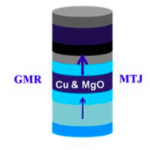
J.-P. Wang, S. S. Sapatnekar, C. H. Kim, P. Crowell, S. Koester, S. Datta, K. Roy, A. Raghunathan, X. S. Hu, M. Niemier, A. Naeemi, C.-L. Chien, C. Ross, and R. Kawakami, in Proceedings of the 54th Annual Design Automation Conference 2017 (ACM, Austin, TX, USA, 2017), pp. 1. pdf |

Strontium Oxide Tunnel Barriers for High Quality Spin Transport and Large Spin Accumulation in GrapheneSimranjeet Singh, Jyoti Katoch, Tiancong Zhu, Ryan J. Wu, Adam S. Ahmed, Walid Amamou, Dongying Wang, K Andre Mkhoyan and Roland K. Kawakami, Nano Letters 17, 7578–7585 (2017). pdf |

Spatially Resolving Density-Dependent Screening Around a Single Charged Atom in GrapheneDillon Wong, Fabiano Corsetti, Yang Wang, Victor W. Brar, Hsin-Zon Tsai, Qiong Wu, Roland K. Kawakami, Alex Zettl, Arash A. Mostofi, Johannes Lischner, and Michael F. Crommie, Physical Review B 95, 205419 (2017). |

Uniform Large-Area Growth of Nanotemplated High-Quality Monolayer MoS2, Applied Physics Letters 110, 263103 (2017). |

Opto-Valleytronic Spin Injection in Monolayer MoS2/Few-Layer Graphene Hybrid Spin ValvesYunqiu (Kelly) Luo, Jinsong Xu, Tiancong Zhu, Guanzhong Wu, Elizabeth Joan McCormick, Mahesh R. Neupane, Wenbo Zhan, and Roland K. Kawakami, Nano Letters 17, 3877–3883 (2017). pdf |

Molecular Beam Epitaxy Growth of [CrGe/MnGe/FeGe] Superlattices: Toward Artificial B20 Skyrmion Materials with Tunable InteractionsAdam S. Ahmed, Bryan D. Esser, James Rowland, David W. McComb, and Roland K. Kawakami, Journal of Crystal Growth 467, 38-46 (2017). pdf |

Growth of Uniform CaGe2 Films by Alternating Layer Molecular Beam EpitaxyJinsong Xu, Jyoti Katoch, Adam S. Ahmed, Igor V. Pinchuk, Justin R. Young, Ezekiel Johnston-Halperin, Jonathan Pelz, Roland. K. Kawakami, Journal of Crystal Growth 460, 134-138 (2017). pdf |

Molecular Beam Epitaxy of 2D-Layered Gallium Selenide on GaN SubstratesChoong Hee Lee, Sriram Krishnamoorthy, Dante J. O’Hara, Jared M. Johnson, John Jamison, Roberto C. Myers, Roland K. Kawakami, Jinwoo Hwang, Siddharth Rajan, Journal of Applied Physics 121, 094302 (2017). pdf |

Strong Modulation of Spin Currents in Bilayer Graphene by Static and Fluctuating Proximity Exchange FieldsSimranjeet Singh, Jyoti Katoch, Tiancong Zhu, Keng-Yuan Meng, Tianyu Liu, Jack T. Brangham, Fengyuan Yang, Michael Flatté and Roland K. Kawakami, Physical Review Letters 118, 187201 (2017). pdf Editors’ Suggestion |
2016

The Effect of Preparation Conditions on Raman and Photoluminescence of Monolayer WS2Kathleen M. McCreary, Aubrey T. Hanbicki, Simranjeet Singh, Roland K. Kawakami, Glenn G. Jernigan, Masa Ishigami, Amy Ng, Todd H. Brintlinger, Rhonda M. Stroud, and Berend T. Jonker, Scientific Reports 6, 35154 (2016). pdf |

Spatially Resolved Electronic Properties of Single-Layer WS2 on Transition Metal OxidesSøren Ulstrup*, Jyoti Katoch*, Roland J. Koch, Daniel Schwarz, Simranjeet Singh, Kathleen M. McCreary, Hyang Keun Yoo, Jinsong Xu, Berend T. Jonker, Roland K. Kawakami, Aaron Bostwick, Eli Rotenberg, and Chris Jozwiak, ACS Nano 10, 10058-10067 (2016). pdf |

NaSn2As2: An Exfoliatable Layered van der Waals Zintl PhaseMaxx Q. Arguilla*, Jyoti Katoch*, Kevin Krymowski, Nicholas D. Cultrara, Jinsong Xu, Xiaoxiang Xi, Amanda Hanks, Shishi Jiang, Richard D. Ross, Roland J. Koch, Søren Ulstrup, Aaron Bostwick, Chris Jozwiak, David W. McComb, Eli Rotenberg, Jie Shan, Wolfgang Windl, Roland Kawakami, and Joshua E. Goldberger, ACS Nano 10, 9500-9508 (2016). pdf |

Nanosecond spin relaxation times in single layer graphene spin valves with hexagonal boron nitride tunnel barriersSimranjeet Singh, Jyoti Katoch, Jinsong Xu, Cheng Tan, Tiancong Zhu, Walid Amamou, James Hone, and Roland Kawakami, Applied Physics Letters 109, 122411 (2016). pdf |
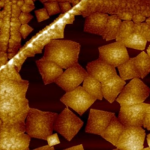
Molecular beam epitaxy growth of SrO buffer layers on graphite and graphene for the integration of complex oxidesAdam Ahmed, Hua Wen, Taisuke Ohta, Igor Pinchuk, Tiancong Zhu, Thomas Beechem, Roland Kawakami, Journal of Crystal Growth 447, 5 (2016). pdf |

Contact induced spin relaxation in graphene spin valves with Al2O3 and MgO tunnel barriersWalid Amamou, Zhisheng Lin, Jeremiah van Baren, Serol Turkyilmaz, Jing Shi, and Roland K. Kawakami, APL Materials 4, 032503 (2016). pdf |

Experimental Demonstration of XOR Operation in Graphene Magnetologic Gates at Room TemperatureHua Wen, Hanan Dery, Walid Amamou, Tiancong Zhu, Zhisheng Lin, Jing Shi, Igor Žutić, Ilya Krivorotov, Lu J. Sham, Roland K. Kawakami, Phys. Rev. Applied 5, 044003 (2016). pdf |

Exchange-Driven Spin Relaxation in Ferromagnet-Oxide-Semiconductor HeterostructuresYu-Sheng Ou, Yi-Hsin Chiu, N. J. Harmon, Patrick Odenthal, Matthew Sheffield, Michael Chilcote, R. K. Kawakami, M. E. Flatté, and E. Johnston-Halperin Phys. Rev. Lett. 116, 107201 (2016). pdf |
2015

Ferromagnetic resonance spin pumping and electrical spin injection in silicon-based metal-oxide-semiconductor heterostructuresYong Pu, Patrick M. Odenthal, Rohan Adur, Jonas Beardsley, Adrian G. Swartz, Denis V. Pelekhov, Michael E. Flatté, Roland K. Kawakami, Jon Pelz, P. Chris Hammel, Ezekiel Johnston-Halperin, Phys. Rev. Lett. 115, 246602 (2015). pdf |

Large area epitaxial germanane for electronic devicesWalid Amamou, Patrick M. Odenthal, Elizabeth J. Bushong, Dante J. O’Hara, Yunqiu Kelly Luo, Jeremiah van Baren, Igor Pinchuk, Yi Wu, Adam S. Ahmed, Jyoti Katoch, Marc W. Bockrath, Harry W. K. Tom, Joshua E. Goldberger and Roland K. Kawakami, 2D Materials 2, 035012 (2015) pdf |

Correlating spin transport and electrode magnetization in a graphene spin valve: Simultaneous magnetic microscopy and non-local measurementsAndrew J. Berger, Michael R. Page, Hua Wen, Kathleen M. McCreary, Vidya P. Bhallamudi, Roland K. Kawakami, and P. Chris Hammel, Applied Physics Letters 107, 142406 (2015). pdf |

Tuning the dynamic exchange interaction in ferromagnet/semiconductor heterostructuresYu-Sheng Ou, Yi-Hsin Chiu, N. J. Harmon, Patrick Odenthal, Matthew Sheffield, Michael Chilcote, R. K. Kawakami, M. E. Flatté, E. Johnston-Halperin, SPIE 9551, 95510E (2015). |

Spin Amplification by Controlled Symmetry Breaking for Spin-Based LogicRoland K. Kawakami, 2D Materials 2, 034001 (2015). |
2014

Graphene SpintronicsWei Han, Roland K. Kawakami, Martin Gmitra, and Jaroslav Fabian, Nature Nanotechnology 9, 794–807 (2014). |

Current-Based Detection of Nonlocal Spin Transport in Graphene for Spin-Based Logic ApplicationsHua Wen, Tiancong Zhu, Yunqiu Kelly Luo, Walid Amamou, Roland K Kawakami, Journal of Applied Physics 115, 17B741 (2014) |

Magnetization dynamics of cobalt grown on grapheneAndrew J. Berger, Walid Amamou, Shane P. White, Rohan Adur, Yong Pu, Roland K. Kawakami, P. Chris Hammel, Journal of Applied Physics 115, 17C510 (2014) |

Spin Polarization of Co(0001)/graphene junctions from first principlesGilherme Sipahi, Igor Zutic, N.Atodiresei, Roland Kawakami, Predrag Lazic, Journal of Physics: Condensed Matter 26, 104204 (2014) |

Direct Comparison of Graphene Devices Before and After Transfer to Different SubstratesRaymond Sachs, Zhisheng Lin, Patrick Odenthal, Roland Kawakami, Jing Shi, Applied Physics Letters 104, 033103 (2014) |

Epitaxial Co-Deposition Growth of CaGe2 Films by Molecular Beam Epitaxy for Large Area GermananeIgor V Pinchuk, Patrick M Odenthal, Adam S Ahmed, Walid Amamou, Joshua E Goldberger, Roland K Kawakami, Journal of Materials Research 29, 410-416 (2014) pdf |
|
2013

A systematic approach to interpreting Hanle spin precession data in non-local spin valvesAdrian G. Swartz, Kathleen M. McCreary, Wei Han, Hua Wen, Roland K. Kawakami, SPIE NanoScience+ Engineering 8813, 881328 (2013) |

Correlation of electrical spin injection and non-linear charge-transport in Fe/MgO/SiYong Pu, Jonas Beardsley, Patrick M. Odenthal, Adrian G. Swartz, Roland K. Kawakami, P. Chris Hammel, Ezekiel Johnston-Halperin, Jairo Sinova, Jon P. Pelz, Applied Physics Letters 103, 012402 (2013) |

Integrating MBE materials with graphene to induce novel spin-based phenomenaAdrian G Swartz, Kathleen M McCreary, Wei Han, Jared JI Wong, Patrick M Odenthal, Hua Wen, Jen-Ru Chen, Roland K Kawakami, Yufeng Hao, Rodney S Ruoff, Jaroslav Fabian, Journal of Vacuum Science and Technology B 31, 04D105 (2013) |

Controlled argon beam-induced desulfurization of monolayer molybdenum disulfideQ. Ma, P. M. Odenthal, J. Mann, D. Le, C. S. Wang, Y. Zhu, T. Chen, D. Sun, K. Yamaguchi, T. Tran, M. Wurch, J. L McKinley, J. Wyrick, K. M. Magnone, T. F. Heinz, T. S. Rahman, R. Kawakami, L. Bartels, Journal of Physics: Condensed Matter 25, 252201 (2013) |

Facile Growth of Monolayer MoS2 Film Areas on SiO2John Mann, Dezheng Sun, Quan Ma, Jen-Ru Chen, Edwin Preciado, Taisuke Ohta, Bogdan Diaconescu, Koichi Yamaguchi, Tai Tran, Michelle Wurch, KatieMarie Magnone, Tony F Heinz, Gary L Kellogg, Roland Kawakami, Ludwig Bartels, The European Physical Journal B 86, 1-4 (2013) |

Control of Schottky Barriers in Single Layer MoS2 Transistors with Ferromagnetic ContactsJen-Ru Chen, Patrick M. Odenthal, Adrian G. Swartz, George Floyd Christensen, Hua Wen, Kelly Yunqiu Luo, Roland K Kawakami, Nano Letters 13, 3106-3110 (2013) |
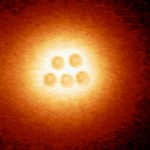
Observing Atomic Collapse Resonances in Artificial Nuclei on GrapheneYang Wang, Dillon Wong, Andrey V Shytov, Victor W Brar, Sangkook Choi, Qiong Wu, Hsin-Zon Tsai, William Regan, Alex Zettl, Roland K Kawakami, Steven G Louie, Leonid S Levitov, Michael F Crommie, Science 340, 734-737 (2013) |

Effect of in situ deposition of Mg adatoms on spin relaxation in grapheneAdrian G Swartz, Jen-Ru Chen, Kathleen M McCreary, Patrick M Odenthal, Wei Han, and Roland K Kawakami, Phys. Rev. B 87, 075455 (2013) |

Measuring the Casimir force gradient from graphene on a SiO2 substrateA. A. Banishev, H. Wen, J. Xu, R. K. Kawakami, G. L. Klimchitskaya, V. M. Mostepanenko, and U. Mohideen, Physical Review B 87, 205433 (2013) |

Comparison of spin lifetimes in n-Ge characterized between three-terminal and four-terminal nonlocal Hanle measurementsL.T. Chang, W. Han, Y. Zhou, J. Tang, I. A. Fischer, M. Oehme, J. Schulze, R. K. Kawakami, and K. L. Wang, Semiconductor Science and Technology 28, 015018 (2013) |
2012

Integration of the ferromagnetic insulator EuO onto grapheneAdrian G. Swartz, Patrick M. Odenthal, Yufeng Hao, Rodney S. Ruoff, and Roland K. Kawakami, ACS Nano 6, 10063-10069 (2012) |
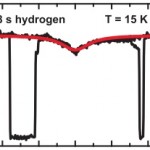
Magnetic moment formation in graphene detected by scattering of pure spin currentsKathleen M. McCreary, Adrian G. Swartz, Wei Han, Jaroslav Fabian, and Roland K. Kawakami, Phys. Rev. Lett. 109, 186604 (2012) |

Electric field control of the Verwey transition and induced magnetoelectric effect in magnetiteJared J. I. Wong, Adrian G. Swartz, Renjing Zheng, Wei Han, and Roland K. Kawakami, Phys. Rev. B (Rapid Comm.) 86, 060409 (2012) |

Spin relaxation in single-layer graphene with tunable mobilityWei Han, Jen-Ru Chen, Deqi Wang, Kathleen M. McCreary, Hua Wen, Adrian G. Swartz, Jing Shi, and Roland K. Kawakami, Nano Lett. 12, 3443-3447 (2012) |
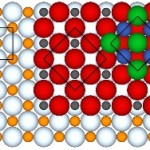
TiO2 as an electrostatic template for epitaxial growth of EuO on MgO(001) by reactive molecular beam epitaxyAdrian G. Swartz, Jared J. I. Wong, Igor V. Pinchuk, and Roland K. Kawakami, J. Appl. Phys. 111, 083912 (2012) |
2011

Electrical spin injection and transport in germaniumYi Zhou, Wei Han, Li-Te Chang, Faxian Xiu, Minsheng Wang, Michael Oehme, Inga A. Fischer, Joerg Schulze, Roland K. Kawakami, and Kang L. Wang, Phys. Rev. B 84, 125323 (2011) Dataset |

REVIEW: Spin transport and relaxation in grapheneWei Han, Kathleen M. McCreary, Kyle Pi, Wei-Hua Wang, Yan Li, Hua Wen, Jen-Ru Chen, and Roland K. Kawakami, J. Magn. Magn. Mater. 324, 369 (2012). Dataset |
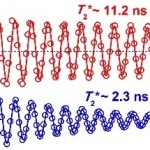
Thermal annealing effect on spin coherence in ZnO single crystalsZ. Yang, Y. Li, D. C. Look, H. M. Zhou, W. V. Chen, R. K. Kawakami, P. K. L. Yu, and J. L. Liu, J. Appl. Phys. 110, 016101 (2011) |

Enhanced spin injection efficiency and extended spin lifetimes in graphene spin valvesWei Han, Jen-Ru Chen, Kathleen M. McCreary, Hua Wen, and Roland K. Kawakami, Proc. SPIE, Vol. 8100, 81000Q (2011) Dataset |

Spin relaxation in single-layer and bilayer grapheneWei Han, Roland K. Kawakami, Phys. Rev. Lett. 107, 047207 (2011) Dataset |

Metallic and insulating adsorbates on grapheneKathleen M. McCreary, Kyle Pi, and Roland K. Kawakami, Appl. Phys. Lett. 98, 192101 (2011) Dataset |
2010

Epitaxial EuO thin films on GaAsAdrian G. Swartz, John Ciraldo, Jared J. I. Wong, Yan Li, Wei Han, Tao Lin, Shawn Mack, Jing Shi, David D. Awschalom, and Roland K. Kawakami, Appl. Phys. Lett. 97, 112509 (2010) |

Tunneling Spin Injection into Single Layer GrapheneWei Han, Kyle Pi, , Kathleen M. McCreary, Yan Li, Jared J. I. Wong, Adrian G. Swartz and Roland K. Kawakami, Phys. Rev. Lett. 105, 167202 (2010) |

Oscillatory Spin Polarization and Magneto-Optical Kerr Effect in Fe3O4 Thin Films on GaAs(001)Yan Li, Wei Han, Adrian G. Swartz, Kyle Pi, Jared J. I. Wong, Shawn Mack and David D. Awschalom and Roland K. Kawakami, Phys. Rev. Lett. 105, 167203 (2010) |

Room-Temperature Electric-Field Controlled Ferromagnetism in Mn0.05Ge0.95 Quantum DotsFaxian Xiu, Yong Wang, Jiyoung Kim, Pramey Upadhyaya, Yi Zhou, Xufeng Kou, Wei Han, Roland K. Kawakami, Jin Zou and Kang L. Wang, ACS Nano 4, 4948-4954 (2010) |
 Manipulation of Spin Transport in Graphene by Surface Chemical DopingKyle Pi, Wei Han, Kathleen M. McCreary, Adrian G. Swartz, Yan Li, and Roland K. Kawakami, Phys. Rev. Lett. 104, 187201 (2010) |

Effect of cluster formation on graphene mobilityKathleen M. McCreary, Kyle Pi, Adrian G. Swartz, Wei Han, Wenzhong Bao, Chun Ning Lau, Francisco Guinea, Mikhail I. Katsnelson, and Roland K. Kawakami, Phys. Rev. B 81, 115453 (2010) |
 Tailoring interlayer exchange coupling of ferromagnetic films across MgO with Fe nanoclustersJared J. I. Wong, Luciana Ramirez, Adrian G. Swartz, Andrew Hoff, Wei Han, Yan Li, and Roland K. Kawakami, Phys. Rev. B 81, 094406 (2010) |
 Investigating the origin of Fermi level pinning in Ge Schottky junctions using epitaxially grown ultrathin MgO filmsYi Zhou, Wei Han, Yong Wang, Faxian Xiu, Jin Zou, Roland K. Kawakami, and Kang. L. Wang, Appl. Phys. Lett. 96, 102103 (2010) |
|
2009
|
 Electronic doping and scattering by transition metals on grapheneK. Pi, K. M. McCreary, W. Bao, Wei Han, Y. F. Chiang, Yan Li, S.-W. Tsai, C. N. Lau, and R. K. Kawakami, Phys. Rev. B 80, 075406 (2009).Dataset |
|
|
 Oxidation-induced biquadratic coupling in Co/Fe/MgO/Fe(001)Y. F. Chiang, Jared J. I. Wong, X. Tan, Yan Li, K. Pi, W. H. Wang, H. W. K. Tom, and R. K. Kawakami, Phys. Rev. B 79, 184410 (2009) |
|
2008
|
|
|
|
|
|
2006
|
2004
|










